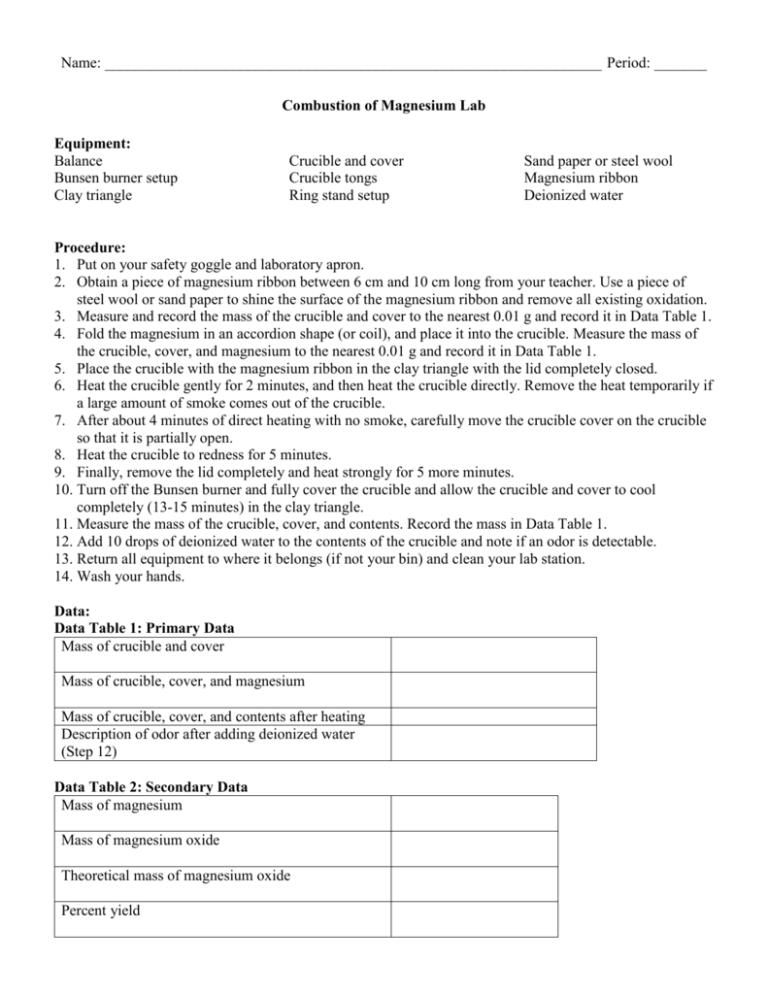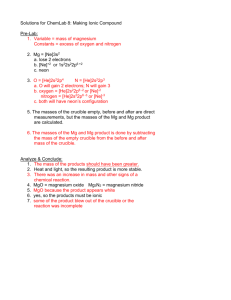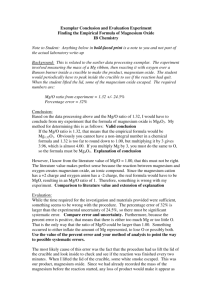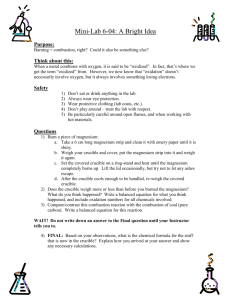Combustion of Magnesium Lab
advertisement

Name: __________________________________________________________________ Period: _______ Combustion of Magnesium Lab Equipment: Balance Bunsen burner setup Clay triangle Crucible and cover Crucible tongs Ring stand setup Sand paper or steel wool Magnesium ribbon Deionized water Procedure: 1. Put on your safety goggle and laboratory apron. 2. Obtain a piece of magnesium ribbon between 6 cm and 10 cm long from your teacher. Use a piece of steel wool or sand paper to shine the surface of the magnesium ribbon and remove all existing oxidation. 3. Measure and record the mass of the crucible and cover to the nearest 0.01 g and record it in Data Table 1. 4. Fold the magnesium in an accordion shape (or coil), and place it into the crucible. Measure the mass of the crucible, cover, and magnesium to the nearest 0.01 g and record it in Data Table 1. 5. Place the crucible with the magnesium ribbon in the clay triangle with the lid completely closed. 6. Heat the crucible gently for 2 minutes, and then heat the crucible directly. Remove the heat temporarily if a large amount of smoke comes out of the crucible. 7. After about 4 minutes of direct heating with no smoke, carefully move the crucible cover on the crucible so that it is partially open. 8. Heat the crucible to redness for 5 minutes. 9. Finally, remove the lid completely and heat strongly for 5 more minutes. 10. Turn off the Bunsen burner and fully cover the crucible and allow the crucible and cover to cool completely (13-15 minutes) in the clay triangle. 11. Measure the mass of the crucible, cover, and contents. Record the mass in Data Table 1. 12. Add 10 drops of deionized water to the contents of the crucible and note if an odor is detectable. 13. Return all equipment to where it belongs (if not your bin) and clean your lab station. 14. Wash your hands. Data: Data Table 1: Primary Data Mass of crucible and cover Mass of crucible, cover, and magnesium Mass of crucible, cover, and contents after heating Description of odor after adding deionized water (Step 12) Data Table 2: Secondary Data Mass of magnesium Mass of magnesium oxide Theoretical mass of magnesium oxide Percent yield Calculations, Analysis, and Conclusions: 1. What mass of magnesium reacted? 2. What mass of magnesium oxide was produced (after heating)? 3. Write a full balanced chemical reaction (including state symbols) for the reaction that took place in this experiment. (The burning of magnesium metal in air) 4. Using stoichiometry, and assuming that magnesium is the limiting reagent, predict the mass of magnesium oxide that should be produced. 5. Calculate your percent yield using the formula below. Actual Mass * 100 = Percent Yield Theoretical Mass 6. When heated to a high enough temperature, magnesium will react with the nitrogen in air. Write a balanced chemical reaction for this reaction. 7. When water reacts with magnesium nitride, ammonia gas (NH3) and magnesium hydroxide are formed. Write a balanced equation for the reaction of magnesium nitride and water. 8. When magnesium hydroxide is heated it decomposes. Write a balanced chemical equation for this reaction. 9. Give one reason it is important to begin with a clean and dry crucible. 10. What is the purpose of making sure the surface of the magnesium ribbon is clean and shiny? 11. What are two potential sources of error that could have adversely affected your results?








